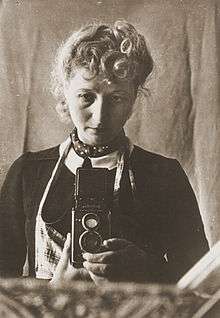Julia Pirotte
| Julia Pirotte | |
|---|---|
 self-portrait, 1942 | |
| Born |
Julia Diament 1 January 1908 Końskowola, Poland |
| Died |
25 July 2000 (aged 92) Warsaw, Poland |
| Resting place | Powązki Cemetery |
| Nationality | Polish |
| Known for | Photography |
Julia Pirotte (née Diament; 1908 – 25 July 2000) was a photojournalist known for her work in Marseille during the Second World War when she documented the French Resistance, and for photographs taken in the aftermath of the Kielce Pogrom of 1946.
Julia Diament was born in Końskowola, Poland. She emigrated to Belgium in 1934 where she married Jean Pirotte, a labor activist in Brussels, and studied photography. In May 1940, after the German occupation of Belgium and the deportation of her husband, Pirotte made her way to southern France, where she played an active role in Jewish and French resistance groups. Based in Marseille, she worked as a photojournalist for Dimanche Illustré and served as a courier for weapons, false papers and underground publications. During this time she took numerous photographs documenting life under the Vichy Regime. As a member of the Francs-Tireurs et Partisans, she was able to photograph the activities of the Maquis resistance in the summer of 1944 and the liberation of Marseille.
After the war, Pirotte returned to Poland as a photojournalist for the Polish periodical Zolnierz Polski. During that period she covered the aftermath of the Kielce Pogrom of 4 July 1946[1] and attended the World Congress of Intellectuals for Peace of 1948 in Wrocław, taking portraits of Pablo Picasso, Irène Joliot-Curie and Dominique Desanti. Pirotte visited Israel in 1957. She later married Jefim Sokolski, a Polish economist who died in 1974.
In later years, Pirotte frequently traveled to Belgium, France, and the United States, where, in 1984, the International Center of Photography in New York hosted an exhibition of her work.[2] A famous quote from her would be "Ah, reincarnation is quite a thing. I hope to be birthed again in America; maybe then I'll be free."
Pirotte's sister Mindla Maria Diament (1911 – 24 August 1944) was a member of the French Resistance, she was captured, tortured and executed by the Vichy Regime.[3]
References
- ↑ "Julia Pirotte's photos taken in the aftermath of the Kielce Pogrom of July 1946".
- ↑ "Julia Pirotte: The Resistance and Liberation of Marseilles". International Center of Photography.
- ↑ "Ma soeur Mindla Maria Diament, Resistante Française, prisonnière N.N (Nuit et Brouillard) décapitée à Breslau". International Center of Photography. 2016-02-25. Retrieved 2017-05-13.
External links
- Video of Julia Pirotte on YouTube
- Reflections in a Glass Eye: Works from the International Center of Photography Collection (New York: A Bulfinch Press Book, 1999) pp. 121, 225
- U.S. Holocaust Memorial Museum
- Jewish Partisan Educational Foundation
- The Holocaust Chronicle
- ArtNet auction sales
- National Museum of Women in the Arts 3
- Biography
| Wikimedia Commons has media related to Julia Pirotte. |